
Heavitree - photos of an area
Page updated 20th July 2015
I would welcome photographs for this page of people, places and events of Heavitree during the last 150 years – if you have a photo, with or without an interesting story, contact me here.
Back to Photo Essays
 A
view down North Street from Fore Street, with the old street lamp
installed by Councillor Nethercott in May 1912, in the middle of the
road. It was a gas light, designed to be self-lighting, and timed
to come on at 9pm. The unveiling was attended by a crowd of several
hundred, when, after Councillor Nethercott drew back the covering, the
National Anthem was sung, accompanied by a single cornet. Until the
1960s, there was a subterranean gents lavatory immediately behind the
lamp, and behind that, a blue police box. The building to the left (the
Indian restaurant) was a hairdressers, and then a Crown Post Office. Photo Express
& Echo.
A
view down North Street from Fore Street, with the old street lamp
installed by Councillor Nethercott in May 1912, in the middle of the
road. It was a gas light, designed to be self-lighting, and timed
to come on at 9pm. The unveiling was attended by a crowd of several
hundred, when, after Councillor Nethercott drew back the covering, the
National Anthem was sung, accompanied by a single cornet. Until the
1960s, there was a subterranean gents lavatory immediately behind the
lamp, and behind that, a blue police box. The building to the left (the
Indian restaurant) was a hairdressers, and then a Crown Post Office. Photo Express
& Echo.
 Fore Street, Heavitree, looking towards the city in the 1930s. Partridge's, the newsagent at 60 Fore Street is on the right. In the distance can be seen the United Reform Church.
Fore Street, Heavitree, looking towards the city in the 1930s. Partridge's, the newsagent at 60 Fore Street is on the right. In the distance can be seen the United Reform Church.
 The
Mote Lodge Filling Station, Heavitree - 1920s
The
Mote Lodge Filling Station, Heavitree - 1920s
1923 Harry Edmunds
Courtenay filling station
1939 George William Blanchon motor
engineer
1956 Arthur Lionel Underhill filling station.
1967 The
Mote Service Station under J S S James
1973 The Mote Service Station
2009 Tesco Filling Station.
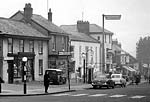 Thorn's
Garage, Heavitree 1950s
Thorn's
Garage, Heavitree 1950s
Thorn's Garage started as a china,
ironmonger and cycle agent in the first war. By 1956, John Thorn and
Sons were an ironmongers, radio and television engineers and motor
engineers, with five Shell pumps between the shop and Fore Street,
Heavitree. The 1967 Kelly's indicates that Thorn's have become Lloyd's
Bank. In the 1940s and 50s many people had radios powered by
accumulators - they were a glass container, 6 inches square, 9 inches
tall, with a carrying handle. Thorn's was a charging point for the
batteries costing 4d for a weeks charge and small boys would collect
the batteries for their neighbours for a small fee. The white building
to the right of Thorns was the old Heavitree School. Photo courtesy of
Den Perrin.
 Forming part of the route out of
Exeter towards Honiton and London, Fore Street, Heavitree was always
the centre of the area. There were, and still are, three public houses
serving the many travellers on the road. The tram route into Exeter ran
along Fore Street.
Forming part of the route out of
Exeter towards Honiton and London, Fore Street, Heavitree was always
the centre of the area. There were, and still are, three public houses
serving the many travellers on the road. The tram route into Exeter ran
along Fore Street.
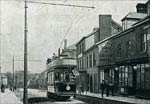 A tram passes the Horse and Groom public house in Fore
Street. The public house that is now named the Heavitree, was run for
several years by the Exeter City and England footballer, Cliff Bastin.
A tram passes the Horse and Groom public house in Fore
Street. The public house that is now named the Heavitree, was run for
several years by the Exeter City and England footballer, Cliff Bastin.
 A view down Church
Street towards Church Lane. Sivell Place is about two thirds down, on
the left. Heavitree
Brewery had its brewing plant in Church Street, on the site of the
present Maltings retirement apartments. The shop on the left has
recently participated in a scheme to redecorate the front in an 'old
Heavitree' style – the owners are to be congratulated on a
superb renovation. The Conservative and Unionist Club are a prominent
occupier
in Church Street, while Richard Ford's
Heavitree House once graced a site opposite the church, but was
demolished for a housing estate after the war.
A view down Church
Street towards Church Lane. Sivell Place is about two thirds down, on
the left. Heavitree
Brewery had its brewing plant in Church Street, on the site of the
present Maltings retirement apartments. The shop on the left has
recently participated in a scheme to redecorate the front in an 'old
Heavitree' style – the owners are to be congratulated on a
superb renovation. The Conservative and Unionist Club are a prominent
occupier
in Church Street, while Richard Ford's
Heavitree House once graced a site opposite the church, but was
demolished for a housing estate after the war.
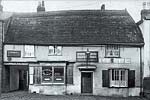 The Royal Oak, the only building
to survive
with a thatched roof in Heavitree, was
first listed in a directory in 1844 as the Royal Oak Tavern. It was
badly bomb damaged in the
blitz and rebuilt after the war. The original Royal Oak moved from
further up Fore Street to this site in the 1820s.
The Royal Oak, the only building
to survive
with a thatched roof in Heavitree, was
first listed in a directory in 1844 as the Royal Oak Tavern. It was
badly bomb damaged in the
blitz and rebuilt after the war. The original Royal Oak moved from
further up Fore Street to this site in the 1820s.
 A Heavitree destined
tram allows two passengers to alight in Heavitree Road, near the Polsloe Road junction. The original horse
tram ran from Eastgate along Heavitree Road. The electric tram track
terminated at Crosspark Terrace.
A Heavitree destined
tram allows two passengers to alight in Heavitree Road, near the Polsloe Road junction. The original horse
tram ran from Eastgate along Heavitree Road. The electric tram track
terminated at Crosspark Terrace.
 A
newly completed Heavitree
Brewery delivery lorry would have been a common site in and around the city
before the brewery, in Church Street, closed in 1970. Courtesy of John
Hill.
A
newly completed Heavitree
Brewery delivery lorry would have been a common site in and around the city
before the brewery, in Church Street, closed in 1970. Courtesy of John
Hill.
 The Heavitree Cricket Club with their
trophies in the 1930s. Before the Second War, Heavitree Cricket Club
had its pitch in the grounds of Wonford House in Barrack Road, on an
area now filled by the Royal Devon and Exeter Hospital. They were
Division One Shield winners 1924, runners-up 1931; Premier Division
winners 1936, 1937, joint holders 1933, runners-up 1935; Devon County
Cup winners 1927, 1932, 1938, joint holders 1930 and 1939. Photo and
stats courtesy of Phil Hoare.
The Heavitree Cricket Club with their
trophies in the 1930s. Before the Second War, Heavitree Cricket Club
had its pitch in the grounds of Wonford House in Barrack Road, on an
area now filled by the Royal Devon and Exeter Hospital. They were
Division One Shield winners 1924, runners-up 1931; Premier Division
winners 1936, 1937, joint holders 1933, runners-up 1935; Devon County
Cup winners 1927, 1932, 1938, joint holders 1930 and 1939. Photo and
stats courtesy of Phil Hoare.
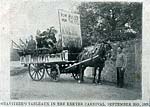 Exeter
once had a Carnival and the annual Cart Horse Parade. The caption for
this postcard indicates that this is Heavitree's entry for Exeter
Carnival in 1905. Entitled 'How Buller Won the VC', it has a
tableaux on the cart of General Sir Redvers Buller and his horse during
the Zulu Wars in South Africa. Just two weeks before the Carnival, on
the 6th September 1905, the large, equestrian statue of the General had been unveiled
at the junction of Hele and New North Road.
Exeter
once had a Carnival and the annual Cart Horse Parade. The caption for
this postcard indicates that this is Heavitree's entry for Exeter
Carnival in 1905. Entitled 'How Buller Won the VC', it has a
tableaux on the cart of General Sir Redvers Buller and his horse during
the Zulu Wars in South Africa. Just two weeks before the Carnival, on
the 6th September 1905, the large, equestrian statue of the General had been unveiled
at the junction of Hele and New North Road.
 St
Michaels Church,
Heavitree is a mostly Victorian rebuild of an much older church dating
from as early as 1152. The postcard shows the churchyard about a
hundred years ago, before the grassed area in the foreground was filled
with graves. The photo was probably taken from the edge of Church Lane.
The opposite site of the lane, which is the Royal Devon and Exeter
Hospital, was open fields then. An altogether, more rural area than
today.
St
Michaels Church,
Heavitree is a mostly Victorian rebuild of an much older church dating
from as early as 1152. The postcard shows the churchyard about a
hundred years ago, before the grassed area in the foreground was filled
with graves. The photo was probably taken from the edge of Church Lane.
The opposite site of the lane, which is the Royal Devon and Exeter
Hospital, was open fields then. An altogether, more rural area than
today.

 It is difficult to believe
that this small country bridge (right) is now the staggered junction of
Rifford Road, East Wonford Hill, Sweetbrier Lane and Honiton Road,
along with the painted yellow boxes and multiple traffic lights. It was
an area (left) prone to flooding due to the Northbrook. It rises near
Little Gratnor field, Stoke Hill, flows down the valley through Polsloe
as the Mincinglake Brook or Whipton Brook, and was locally known as
'The Panny'. The lower length has been known as the Wonford Brook or
Wonbroke and Northbrook. It flowed under the bridge and across the
Topsham Road on its way to the Exe. The bridge disappeared when the road between the bridge and Gallows Corner was widened in August 1932.
It is difficult to believe
that this small country bridge (right) is now the staggered junction of
Rifford Road, East Wonford Hill, Sweetbrier Lane and Honiton Road,
along with the painted yellow boxes and multiple traffic lights. It was
an area (left) prone to flooding due to the Northbrook. It rises near
Little Gratnor field, Stoke Hill, flows down the valley through Polsloe
as the Mincinglake Brook or Whipton Brook, and was locally known as
'The Panny'. The lower length has been known as the Wonford Brook or
Wonbroke and Northbrook. It flowed under the bridge and across the
Topsham Road on its way to the Exe. The bridge disappeared when the road between the bridge and Gallows Corner was widened in August 1932.
 The houses of Midway Terrace in Heavitree
Road, are similar to, and were developed at the same time as Baring Crescent and Baring Place in
the 1820s. The ten houses, in pairs, were constructed by William Hooper
who was responsible for much development of the old Baring estate of
Heavitree and St Leonards. He lived in No 138, Midway Terrace, where he
died in 1831.
The houses of Midway Terrace in Heavitree
Road, are similar to, and were developed at the same time as Baring Crescent and Baring Place in
the 1820s. The ten houses, in pairs, were constructed by William Hooper
who was responsible for much development of the old Baring estate of
Heavitree and St Leonards. He lived in No 138, Midway Terrace, where he
died in 1831.
 Mont le Grand off Polsloe Road is
considered by some to be the most attractive group of houses in
Heavitree. Constructed in 1840/1 in the Regency style (Exeter always
took a while to catch up with the latest fashion). The name dates from
1837, when Hill House (now Selsdon House) in Polsloe Road was described
as Mont-le-Grand. The houses were occupied by the well off army
officers clergy and professional me who had need of a house large
enough for several children and servants.
Mont le Grand off Polsloe Road is
considered by some to be the most attractive group of houses in
Heavitree. Constructed in 1840/1 in the Regency style (Exeter always
took a while to catch up with the latest fashion). The name dates from
1837, when Hill House (now Selsdon House) in Polsloe Road was described
as Mont-le-Grand. The houses were occupied by the well off army
officers clergy and professional me who had need of a house large
enough for several children and servants.
 Stafford
Terrace is just before Crosspark Terrace as you drive out of the city.
The small lane immediately left leads to Roseland Avenue, while the
left, part way down is Whipton Lane. The houses would
have become desirable residences when the tram reached the terrace.
Drews Almshouse is out of frame, to the right.
Stafford
Terrace is just before Crosspark Terrace as you drive out of the city.
The small lane immediately left leads to Roseland Avenue, while the
left, part way down is Whipton Lane. The houses would
have become desirable residences when the tram reached the terrace.
Drews Almshouse is out of frame, to the right.
 The monkey puzzle tree in
the garden of one of the houses of Crosspark Terrace can be plainly
seen in this Edwardian postcard. A similar tree is flourishing
today.
It is sobering to think that there were four casualties from the
terrace during the First World War – Lance Corporal Leslie
Vincent Castle aged 23 and Private, William Ernest Chapman, aged 19,
Sapper, Martin de Thierry, aged 27 and Lance Corporal, Lionel Laver,
aged 23.
The monkey puzzle tree in
the garden of one of the houses of Crosspark Terrace can be plainly
seen in this Edwardian postcard. A similar tree is flourishing
today.
It is sobering to think that there were four casualties from the
terrace during the First World War – Lance Corporal Leslie
Vincent Castle aged 23 and Private, William Ernest Chapman, aged 19,
Sapper, Martin de Thierry, aged 27 and Lance Corporal, Lionel Laver,
aged 23.
 The bombing of 1942 badly
damaged much of St Lukes College, and the attached St Luke's School.
This photo was taken in 1950, indicating the slow progress of repairs
to the college. Photo Maurice Swansborough.
The bombing of 1942 badly
damaged much of St Lukes College, and the attached St Luke's School.
This photo was taken in 1950, indicating the slow progress of repairs
to the college. Photo Maurice Swansborough.
 The Church of the Blessed
Sacrament was constructed on land that had been the site of a house
named Heavitree House, that pre-dated Richard Ford's Heavitree House in
Church Street. The land was purchased in 1930 and the church
constructed in 1935. The photo shows the church before the blitz
– the tower was badly damaged by a bomb and the top part of the
tower had to be demolished, leaving the modern church with a
truncated tower. It contains a single bell of four tons, which at the
time, was the second heaviest in Devon.
The Church of the Blessed
Sacrament was constructed on land that had been the site of a house
named Heavitree House, that pre-dated Richard Ford's Heavitree House in
Church Street. The land was purchased in 1930 and the church
constructed in 1935. The photo shows the church before the blitz
– the tower was badly damaged by a bomb and the top part of the
tower had to be demolished, leaving the modern church with a
truncated tower. It contains a single bell of four tons, which at the
time, was the second heaviest in Devon.
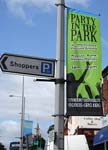
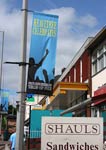 During August 2006,
Heavitree celebrated the centenary of the creation of the Heavitree Pleasure Gardens. The
event was marked with the unveiling of a centenary obelisk by the Lord
Mayor, Peter Wadham, assisted by David Morrish. These banners appeared
along Fore Street to publicise the Party in the Park on August Bank
Holiday Monday. Photos David Cornforth.
During August 2006,
Heavitree celebrated the centenary of the creation of the Heavitree Pleasure Gardens. The
event was marked with the unveiling of a centenary obelisk by the Lord
Mayor, Peter Wadham, assisted by David Morrish. These banners appeared
along Fore Street to publicise the Party in the Park on August Bank
Holiday Monday. Photos David Cornforth.
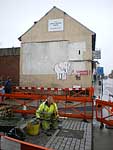
 The white elephant and small dog
graffiti (right) appeared on the end wall of the gun-shop in Fore
Street during 2008 as a protest against the placing of the Voice of Heavitree Arch (left) next to the
side of the shop. Here, workmen are laying new, decorative bricks at
the entrance to Gordon's Place, in preparation for the installation of
the work. Photo left - Exeter City Council, right - David Cornforth.
The white elephant and small dog
graffiti (right) appeared on the end wall of the gun-shop in Fore
Street during 2008 as a protest against the placing of the Voice of Heavitree Arch (left) next to the
side of the shop. Here, workmen are laying new, decorative bricks at
the entrance to Gordon's Place, in preparation for the installation of
the work. Photo left - Exeter City Council, right - David Cornforth.
Sources - Discovering Exeter - Heavitree by Trevor Falla, various trade directories, Phil Hoare and other articles on this site.
│ Top of Page │